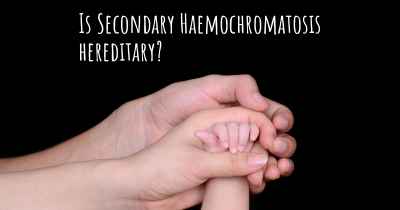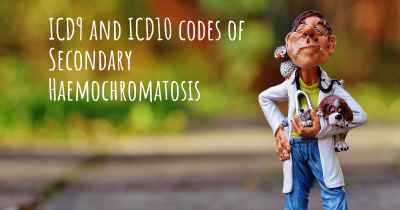Which are the symptoms of Secondary Haemochromatosis?
See the worst symptoms of affected by Secondary Haemochromatosis here

Secondary Haemochromatosis:
Secondary haemochromatosis, also known as acquired or non-hereditary haemochromatosis, is a condition characterized by excessive iron accumulation in the body. Unlike primary haemochromatosis, which is a hereditary disorder, secondary haemochromatosis is caused by other underlying conditions or factors that lead to increased iron absorption or deposition.
Causes:
Secondary haemochromatosis can be triggered by various factors, including:
- Chronic liver diseases: Conditions such as alcoholic liver disease, viral hepatitis, non-alcoholic fatty liver disease (NAFLD), and autoimmune hepatitis can cause secondary haemochromatosis.
- Excessive iron intake: Repeated blood transfusions, excessive iron supplementation, or high dietary iron intake can lead to iron overload and secondary haemochromatosis.
- Anemias: Certain types of anemia, such as thalassemia and sideroblastic anemia, can result in secondary haemochromatosis due to increased iron absorption.
- Chronic kidney disease: Kidney disorders, particularly those requiring dialysis, can cause secondary haemochromatosis.
- Other conditions: Some rare conditions, including porphyria cutanea tarda, dysmetabolic syndrome, and certain malignancies, can also contribute to secondary haemochromatosis.
Symptoms:
The symptoms of secondary haemochromatosis can vary depending on the underlying cause and the extent of iron overload. In the early stages, individuals may not experience any noticeable symptoms. However, as iron accumulates in various organs and tissues, the following symptoms may develop:
- Fatigue: Excessive iron deposition can lead to fatigue and a general feeling of weakness.
- Joint pain: Iron accumulation in the joints can cause pain, stiffness, and swelling.
- Abdominal pain: Some individuals may experience abdominal discomfort or pain, often in the upper right quadrant, due to iron deposition in the liver.
- Weight loss: Unintentional weight loss may occur in some cases.
- Weakness: Iron overload can lead to muscle weakness and decreased physical performance.
- Changes in skin color: The skin may appear bronze or grayish due to increased iron levels.
- Heart problems: Iron accumulation in the heart can cause cardiomyopathy, which may result in symptoms such as shortness of breath, palpitations, and swelling of the legs.
- Diabetes: Secondary haemochromatosis has been associated with an increased risk of developing diabetes mellitus.
- Sexual dysfunction: In men, iron overload can lead to decreased libido, erectile dysfunction, and testicular atrophy.
- Irregular menstruation: Women with secondary haemochromatosis may experience irregular or absent menstrual periods.
Diagnosis and Treatment:
If secondary haemochromatosis is suspected, a healthcare professional will evaluate the patient's medical history, perform a physical examination, and order specific tests to confirm the diagnosis. These tests may include:
- Iron studies: Blood tests measuring serum iron, ferritin, transferrin saturation, and total iron-binding capacity (TIBC) can help assess iron levels.
- Liver function tests: These tests evaluate liver enzymes and function, as iron overload often affects the liver.
- Genetic testing: In some cases, genetic testing may be performed to rule out primary hereditary haemochromatosis.
- Imaging studies: Imaging techniques like magnetic resonance imaging (MRI) or ultrasound may be used to assess iron deposition in organs.
- Liver biopsy: A liver biopsy may be recommended to evaluate the extent of iron accumulation and assess liver damage.
The treatment of secondary haemochromatosis primarily focuses on managing the underlying cause and reducing iron levels in the body. The specific treatment approach may vary depending on the individual's condition, but it often includes:
- Phlebotomy: Regular blood removal (similar to blood donation) is commonly used to reduce iron levels. The frequency and duration of phlebotomy sessions will be determined by the healthcare provider.
- Iron chelation therapy: In cases where phlebotomy is not feasible or sufficient, iron chelating agents may be prescribed. These medications help remove excess iron from the body.
- Treating the underlying condition: Managing the underlying cause of secondary haemochromatosis, such as liver disease or anemia, is crucial to prevent further iron accumulation.
- Dietary modifications: Limiting iron-rich foods and avoiding vitamin C supplements (which enhance iron absorption) may be recommended.
- Regular monitoring: Individuals with secondary haemochromatosis will require ongoing monitoring of iron levels, liver function, and any associated complications.
Conclusion:
Secondary haemochromatosis is a condition characterized by excessive iron accumulation in the body due to underlying factors or conditions. Recognizing the symptoms and seeking medical attention is crucial for early diagnosis and appropriate management. Treatment primarily involves addressing the underlying cause and reducing iron levels through phlebotomy or iron chelation therapy. Regular monitoring is essential to prevent complications associated with iron overload.








